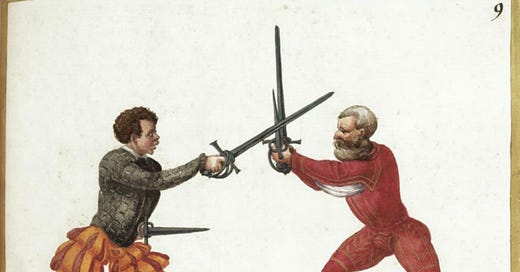Chapter VI: Sword and Dagger
With the sword alone, the body is positioned completely in profile and the body held erect as described in Book 1. In the play of the sword and dagger, the body is not in profile, but the left shoulder follows the dagger hand, and the dagger hand will follow the sword so that its point goes towards it, always following the sword and staying close to it, unless the dagger hand is armored as well as the arm, especially with an armored plate and gauntlet, in which case the dagger makes a secure defense. With these type of weapons the guard is to place the sword with its flat facing the sky with the arm extended and the dagger conjoined to the tip of the sword. Furthermore, the right foot will be forward, the left foot will be sideways, the body not carelessly arranged but well-counterbalanced.
Your opponent will need to attack you with either cuts or thrusts, and if they make a big cut to your left side, block this with sword and dagger together keeping and the dagger yielding to the opponent’s sword while keeping the point of the dagger directed at his body so it can be ready to defend wherever the enemy’s sword should turn and entering with the sword under his arm as high as possible which is a place to make grievous wounds, while also keeping your sword near to the enemy’s sword and so it can easily go to assist your dagger if needed and you must do the same if the enemy attacks with a thrust.
Keep reading with a 7-day free trial
Subscribe to The Art of Arms to keep reading this post and get 7 days of free access to the full post archives.




